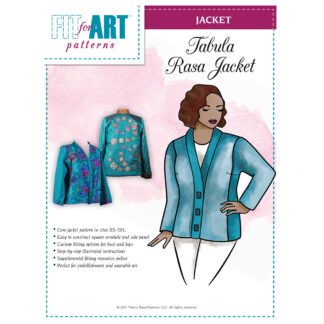
Much of the sewing on a couture French jacket is handwork. I can attest to this fact because even though I spend several hours a day hand stitching, my jacket is not finished. I have found that having a supply of good needles close by is helpful and so is good light. My lining is a dark navy; having enough light is essential to ensure that my stitches are small and hidden in the overlapped seam.

Before I reached the eternal hand stitching stage, there were a couple of other tools that made jacket construction easier. The bouclé presented its first challenge at the sewing machine. For French jacket construction, the sewing machine is used to quilt each lining piece to the bouclé. The machine is also used to sew the seams of the bouclé sections together permanently when you are confident of a good fit. That little note about good fit is crucial to heed because finding the seam stitches in the bouclé to rip out would have been impossible. The seams simply vanish into the fabric.
My greatest challenge was posed by the threads that composed the loosely woven bouclé. My machine needle stitched successfully through most of the fibers, but a couple of the yarns would snag and then jam up the machine as I was quilting.

I had made a small sample before I began to test the needle size and thread colors, but still, the problem of snagging and jamming persisted on the larger pieces. Here are the steps I considered and implemented one at a time to solve the problem:
- Change the needles – I started with a universal 70. I observed that the threads that were snagging were the shiny rayon or microfiber threads, so I changed to a micro-tex 65.
- Change the throat plate – I rarely sew with the straight stitch throat plate because I like having options in my stitch choice and needle position. My hunch was that the snagged threads would not so easily penetrate into the bobbin mechanism with this smaller opening in the straight stitch throat plate.
- Slow down – This was perhaps the hardest for me. I tend to be a speedy stitcher but slowing down really did help. Every time I began to increase my speed, I would again begin to snag threads.
- Sew with the fabric towards the needle and the lining towards the bobbin. Carrie had no trouble with her bouclé because she stitched with the bouclé up and the lining down. I was using the “stripes” between the frogs in the lining as a guide for my quilting, so I chose to stitch with lining up. It might have helped me to switch, but I also had snags when I was sewing two layers of bouclé into a seam, unless I went very slowly and used the correct throat plate and needle.

Honest observation and quick access to the tools I needed worked hand in hand to solve my dilemma.
The last tools I will mention are the pressing tools I found helpful. The sleeve board and ham have been invaluable as I press open and trim the bouclé and then manipulate the lining in the jacket and sleeve seams.
Another pressing tool I am loving is a shoulder stand.

It is a luxury to shape the head of the sleeve before inserting it into the armhole. Edye won this as a door prize at the 2014 ASDP conference. It is made by our friend, and a licensed Eureka! Pants Professional, Linda Homan. At her suggestion, I used it to press open some darts on a different jacket with great success. It is quickly becoming a favorite on my ironing board with its stable base and small size.

You can order one for yourself by contacting her at lhdesign@gci.net, or by visiting her Etsy Page.
Sew News is celebrating its 35th birthday this year. In the current issue I have an article titled “The 35 Essential Tools for Garment Sewers.” Take a look at my recommendations and begin to collect your own set of tools and products that will make your sewing time fun and productive.
What is your favorite sewing tool and how has it improved your garment sewing experience? Share it with our Fit for Art community so we can all benefit.
Happy Sewing, RAE






